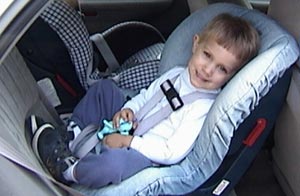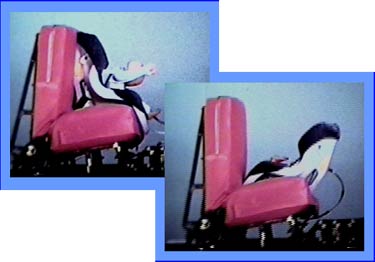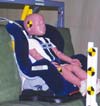|
Rear-facing - Unmatched Safety
Rear-facing is the safest position the child
can ride in. It is strongly recommended that all children stay
rear-facing beyond the minimum requirements of 1 year and 20 lbs. Children
should not be
turned forward-facing until they reach the maximum rear-facing limits of a
convertible seat (that allows rear-facing to at least 30 lbs). These
limits are either the maximum rear-facing weight limit or when the top
of their head is within one inch of the top of the seat shell, whichever comes
first. While most
parents are aware that they must keep their children rear-facing "until they are AT LEAST 1 year old AND 20 lbs", very few are told that there are
significant safety benefits when a child remains rear-facing as long as the seat
allows. For most children, rear-facing can and should continue well into
the second year of life.

Aaron, still happily rear-facing at 3 years old (36 months)
Expert Statements
confirm that rear-facing is safest.
Highlighted passages are links to
original articles.
Rear-facing
CRs provide the best protection from injury for any child that can fit
in one.
- SafetyBeltSafe USA technical encyclopedia, written by Kathleen Weber, retired
Director of the Child Passenger Protection Research Program in the University of
Michigan Medical School
...a child should remain rear-facing for as long as
possible...even beyond their first birthday, increasing their protection
until they are 30 to 35 lbs.
- Dr. Michael Sachs, Pediatrician and Child Passenger Safety Expert
...for optimal protection, the
child should remain rear facing until reaching the maximum weight for the
car safety seat, as long as the top of the head is below the top of the seat
back
- American Academy of Pediatrics policy statement
A
child should stay rear-facing for as long as possible
- Flaura Koplin Winston, MD, PhD, principal investigator of Partners for Child
Passenger Safety, a research collaboration between The Children's Hospital of
Philadelphia and State Farm Insurance Company.
Basically, the
longer a child can ride rear-facing, the better protected his or her spinal cord
is in the event of a collision.�
- Joe Colella, Former Child Passenger Safety Training Manager for the National SAFE
KIDS Campaign
Why should my child rear-face past 1 year and 20 lbs?
Every milestone in a child's
life is exciting! First steps, first word, first day of school. Even car
seat milestones seem exciting. The truth is, they should be looked at
with a certain sense of dread, not longing. Every step in car seat
"advancement" is actually a step down in your child's protection.
Rear-facing is much, much safer than
forward-facing.
Child
safety seats: Rear-face until at least one year discusses the reasons why children should remain
rear-facing for a FULL year and 20 lbs. In it, Kathleen Weber states, "In the
research and accident review that I did a few years ago, the data
seemed to break at about 12 months between severe consequences and more
moderate consequences..." This does not mean that there are NO
consequences. The consequences may no longer be death
from a completely severed
spinal cord, but simply life-long injury, including complete paralysis.
Research studies suggest that until children are
at least four, they are incapable of withstanding crash forces as
well as adults - and should remain rear-facing.
In a crash, life-threatening or fatal injuries are generally limited
to the head and neck, assuming a child is in a harnessed seat.
When a child is in a forward-facing seat,
there is tremendous stress put on the child's neck, which must hold the
large head back. The mass of the head of a small child
is about 25% of the body mass whereas the mass of the adult head is only
6%! A small child's neck sustains massive amounts of force in a
crash. The body is held back by the straps while the head is thrown
forward - stressing, stretching or even breaking the spinal cord.
The child's head is at greater risk in a forward-facing seat as
well. In a crash, the head is thrown outside the
confines of the seat and can make dangerous contact with other occupants,
vehicle structures, and even intruding objects, like trees or other
vehicles.
Rear-facing seats do a phenomenal job of protecting children because there
is little or no force applied to the head, neck and spine. When a
child is in a
rear-facing seat, the head, neck and spine are all kept fully aligned and
the child is allowed to "ride down" the crash while the back of the child
restraint absorbs the bulk of the crash force. The head is contained
within the restraint, and the child is much less likely to come into
contact with anything that might cause head injury.
Notice the
difference in stress on the child's body in the two crash test photos
below.

Courtesy of University of Michigan Child
Passenger Protection
Side by side
comparison
Won't my child be uncomfortable? Where do his
legs go?
Many parents have the misconception that
children are uncomfortable or at risk for leg injury by having their
legs up on the vehicle seat or bent when kept rear-facing. These
concepts are completely incorrect. First, children are more flexible
than adults so what we perceive as uncomfortable is not for children.
Think about how your child sits in everyday play. Do they sit with their
legs straight out in front of them? When they sit on the couch, do they
purposely sit so their legs dangle out over the edge? No. In real,
everyday life, toddlers and preschoolers CHOSE to sit with their legs
folded up - that IS comfort to them.
Second, there is not a single documented
case of children's legs, hips, etc. breaking or being injured in a crash
due to longer rear-facing. There are plenty of cases of head and
neck injury in forward-facing children that could have been prevented if
the child had remained rear-facing. However, even if a leg or hip
were broken or injured, it can be fixed. A damaged spinal cord (from
forward-facing too soon) cannot be repaired and subjects the child to
lifelong disability or death.
What
if I am hit from behind? Won't my child be safer facing forward?
Frontal and side impacts are the most
common type of crashes. They account for 96% of all crashes. They are
also the most deadly type of crashes (especially side impacts) and
rear-facing children have MUCH more protection in both types of crashes
than forward-facing. In the 4% of rear impact crashes that a rear-facing
child would be in, they have at least the same amount of protection that
a FF child would have in a frontal impact, with the added benefit of
less crash energy being transferred to them, and the fact that the rear
impact is usually not as severe.
The forces in a rear impact crash are much different from the forces in
a frontal impact crash. In a frontal impact, the forces are much greater
because the vehicles are usually traveling in opposite directions.
Experts suggest that a frontal crash is the same as hitting a concrete
barrier � the vehicle and all occupants come to a dead stop within less
than 1 second.
When you are struck in a rear impact, the vehicles involved are
traveling in the same direction, and the vehicle that is hit in the back
has room to move forward. The crash force on the occupants is much less
than in a frontal impact. The movement of the impacted vehicle, in
addition to the crush zone, absorbs a lot of the crash energy, so it is
not transferred to the child. Additionally, the majority of rear impacts
are at low speeds.
In short, if your child is rear-facing, he has optimal protection in the
types of crashes you are most likely to be in. If he is forward-facing,
he may have optimal protection in a rear-end crash, but statistically,
that is the least likely to happen and he is 60% more likely to be
injured or killed in the types of crashes (frontal, side impact) you are
most likely to be in.
You can learn more about the physics of rear-facing at
http://www.car-safety.org/rearface.html
Crash Test
Footage

Crash
test of a Forward-Facing child.
All video shown is of European seats. More videos can be found
here. Click on a seat, then in the upper right corner, click on
"Frontcrash-video" or "Seitencrash-Video". Not all seats have video.
The
rear-facing videos
shown here are of a rear-facing seat that is Braced and Tethered. In Sweden,
it is standard practice to keep
their children rear-facing up to the age of 5,
or as
much as 55 lbs. From 1992 through June 1997,
only 9 children properly restrained rear-facing died in motor vehicle
crashes in Sweden, and all of these involved catastrophic crashes with
severe intrusion and few other survivors. Larger Swedish child
restraints are designed to accommodate these larger children.
US-certified restraints can be used rear-facing until the maximum weight
limit is reached or until the top of the child's head is within one inch
of the top of the seat, whichever comes first.
In the US, motor vehicle crashes are the
number one
cause of death for children. The extra protection offered by
rear-facing seats is something that parents should take advantage of as
long as possible.
Other Links
American Academy of Pediatrics 2006 Car Seat Shopping Guide
Why
babies must ride rear-facing
Rear-facing vs. Forward-facing
Car-Safety.org: Why Rear-facing is safest
|